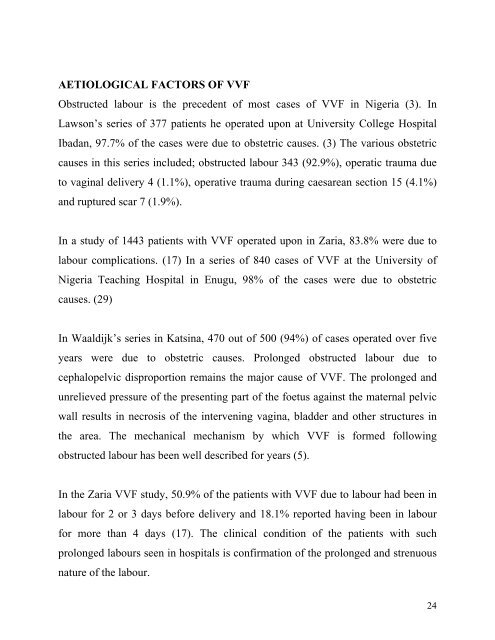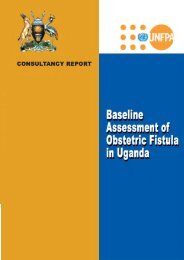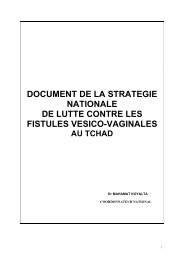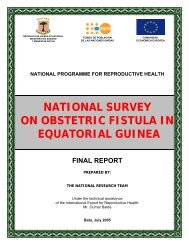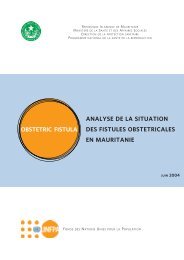report of the rapid assessment of vesico-vaginal fistulae in nigeria
report of the rapid assessment of vesico-vaginal fistulae in nigeria
report of the rapid assessment of vesico-vaginal fistulae in nigeria
You also want an ePaper? Increase the reach of your titles
YUMPU automatically turns print PDFs into web optimized ePapers that Google loves.
AETIOLOGICAL FACTORS OF VVFObstructed labour is <strong>the</strong> precedent <strong>of</strong> most cases <strong>of</strong> VVF <strong>in</strong> Nigeria (3). InLawson’s series <strong>of</strong> 377 patients he operated upon at University College HospitalIbadan, 97.7% <strong>of</strong> <strong>the</strong> cases were due to obstetric causes. (3) The various obstetriccauses <strong>in</strong> this series <strong>in</strong>cluded; obstructed labour 343 (92.9%), operatic trauma dueto <strong>vag<strong>in</strong>al</strong> delivery 4 (1.1%), operative trauma dur<strong>in</strong>g caesarean section 15 (4.1%)and ruptured scar 7 (1.9%).In a study <strong>of</strong> 1443 patients with VVF operated upon <strong>in</strong> Zaria, 83.8% were due tolabour complications. (17) In a series <strong>of</strong> 840 cases <strong>of</strong> VVF at <strong>the</strong> University <strong>of</strong>Nigeria Teach<strong>in</strong>g Hospital <strong>in</strong> Enugu, 98% <strong>of</strong> <strong>the</strong> cases were due to obstetriccauses. (29)In Waaldijk’s series <strong>in</strong> Kats<strong>in</strong>a, 470 out <strong>of</strong> 500 (94%) <strong>of</strong> cases operated over fiveyears were due to obstetric causes. Prolonged obstructed labour due tocephalopelvic disproportion rema<strong>in</strong>s <strong>the</strong> major cause <strong>of</strong> VVF. The prolonged andunrelieved pressure <strong>of</strong> <strong>the</strong> present<strong>in</strong>g part <strong>of</strong> <strong>the</strong> foetus aga<strong>in</strong>st <strong>the</strong> maternal pelvicwall results <strong>in</strong> necrosis <strong>of</strong> <strong>the</strong> <strong>in</strong>terven<strong>in</strong>g vag<strong>in</strong>a, bladder and o<strong>the</strong>r structures <strong>in</strong><strong>the</strong> area. The mechanical mechanism by which VVF is formed follow<strong>in</strong>gobstructed labour has been well described for years (5).In <strong>the</strong> Zaria VVF study, 50.9% <strong>of</strong> <strong>the</strong> patients with VVF due to labour had been <strong>in</strong>labour for 2 or 3 days before delivery and 18.1% <strong>report</strong>ed hav<strong>in</strong>g been <strong>in</strong> labourfor more than 4 days (17). The cl<strong>in</strong>ical condition <strong>of</strong> <strong>the</strong> patients with suchprolonged labours seen <strong>in</strong> hospitals is confirmation <strong>of</strong> <strong>the</strong> prolonged and strenuousnature <strong>of</strong> <strong>the</strong> labour.24


